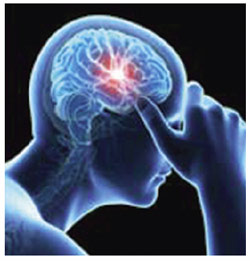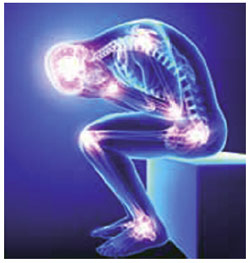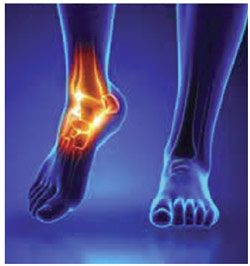 |
 |
 |
|
February 2015 |
This was on September 12, 2014, the day that transformed Sherry’s life, and one she will never forget. “The following day when I went to work, simply using my fingers at the cash register was so painful and then I lost power in my hands. The pain was terrible – no fever – but a rash all over my body, no itchiness. I felt as if my bones had turned to jelly.” The fever came, as did the itchiness: a persistent tingling, especially on the palm of her left hand. “It was always red and felt as it if it was on fire and painful,” she says. It is now the middle of January, just over four months since the first appearance of the virus appeared and she is describing what it has meant for her. Every day, she says, every single day there has been pain, “sometimes worse than others, especially my knees and feet, wrists.” Her feet have been swollen, her hands and fingers too, and there have been days when her eyes have felt like they would fall out. It has improved a little but the pains are still there, though not as intense; and it has not been a straight line towards what she hopes will be a full recovery. “For example on Old Year’s day when I was on my feet all day, everything was all swollen, legs, feet, eyes, nose, lips hands, wrists, everything.” She’s noticed that whenever she’s had a particularly strenuous day, and she has been on her feet a lot, the pain is more intense and the swellings return. She also had a particularly frightening episode of lightheadedness, more intense and unsettling than anything she had ever had before, making her feel not only that she was going to faint, but that she was having a stroke or something like that. (I’d had a similar experience and had discovered at least three others who had as well.) Her blood pressure had also been fluctuating quite frequently.
Today, she is at a doctor’s office, seeking some relief from the unbearable pains in her feet, the alopecia she has discovered in her head and traces of blood in her urine. I have asked to be present. The doctor asks a lot of questions, takes her vitals and begins prodding and poking at the pain sites. “Where does it hurt the most?” “My feet.” Is the pain worse on mornings before you get out of bed?” She says she feels stiff and arthritic and it takes a while before she can warm up. She tells him that more lately her hands and fingers feel like they are losing sensation, as if her blood circulation has stopped and her hands feel cold, heavy and dead. He began tossing around the words ‘carpal tunnel’ (carpal tunnel syndrome is associated with numbness, tingling, weakness and other problems in your hand because of pressure on the median nerve in your wrist), suggesting that surgery could easily fix that. It turns out his specialty is orthopedics, and although he says that for the past few months he has been seeing more than a hundred patients every month presenting similar symptoms, he insists that this is carpal tunnel syndrome. It raises the question I promptly ask. Several people are complaining of similar feelings and sensations, if it is related to the virus, won’t it clear once the virus has gone? There seems to be no answer to this; at least, none is proffered.
In the meantime, the doctor is treating the alopecia areata (hair loss) with a steroid injection, and then he will do something similar to her foot, though this is a very painful procedure. Three days later, the site of the injections is a purple patch, but the pain has eased, she says. He shows her some exercises to do repeatedly during the day, mostly stretches, and recommends that she rests a lot more than she does. An hour has passed and the visit has ended. The bill is $1,000. Is it the Chikungunya virus? He will not say it is, he will not say it isn’t. He does not believe that all the cases that share the symptoms are Chikungunya. There are viruses presenting with similar symptoms, he says. It could be any one of them. Another unconfirmed case. |



 “I remember stepping off the bed and thinking, oh this pain in my feet was probably because of the skipping I did the night before; but as the day progressed my knees started to hurt, my lower back, and then my wrists, at which point I realized it was not the skipping, but something else.”
“I remember stepping off the bed and thinking, oh this pain in my feet was probably because of the skipping I did the night before; but as the day progressed my knees started to hurt, my lower back, and then my wrists, at which point I realized it was not the skipping, but something else.”  Sherry is 44, an energetic mother of three daughters ages 22, 18 and 14, who divides her time between her duties as a manager at the pharmacy her family owns, housekeeping and managing her children’s demands. She is fairly fit she says, because of all the running around she does.
Sherry is 44, an energetic mother of three daughters ages 22, 18 and 14, who divides her time between her duties as a manager at the pharmacy her family owns, housekeeping and managing her children’s demands. She is fairly fit she says, because of all the running around she does.  Many doctors are predicting chronic arthritis and rheumatoid arthritis and reactive arthritis that may be corrosive and erosive and may trigger other conditions. Some say that it will all pass over time. What kind of time? The answers vary widely. It might be days, weeks, months or years. Although older people seem more likely to feel more prolonged effects, it is not yet clear what determines the duration.
Many doctors are predicting chronic arthritis and rheumatoid arthritis and reactive arthritis that may be corrosive and erosive and may trigger other conditions. Some say that it will all pass over time. What kind of time? The answers vary widely. It might be days, weeks, months or years. Although older people seem more likely to feel more prolonged effects, it is not yet clear what determines the duration.